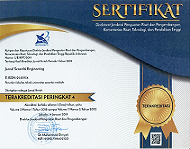Pembuatan Glukosa dari Fiber Cake Sawit dengan Metode Hidrolisis Enzim Selulase
Keywords:
Fiber Cake Sawit, Lignin, Enzim Selulase, Delignifikasi, Hidrolisis EnzimatisAbstract
Palm fiber cake is waste from the palm oil processing process after going through the oil extraction process from oil palm fruit. Fiber cake contains lignocellulose in the form of cellulose, hemicellulose, and lignin. The high cellulose content in fiber cake will be used to produce monosaccharides to produce glucose. Lignin contained in palm fiber cake needs to be removed to extract cellulose because lignin functions as a protector that will prevent enzymes from breaking down cellulose into glucose. The delignification process is carried out to remove lignin levels, using H2O2 and MnSO4.H2O as catalysts to accelerate the reaction process. To convert cellulose into glucose, an enzymatic hydrolysis process is carried out using the cellulase enzyme. This study aims to determine the glucose levels produced through the hydrolysis process by varying the cellulase enzyme by 5%, 10%, and 15% of the weight of delignified palm fiber cake, with sampling times at 6, 12, and 18 hours. Based on the analysis results, the highest glucose results were obtained in sample C3 (enzyme concentration 15%/18 hours), which was 9% in the Luff Schoorl analysis and a brix value of 12°Bx with a pH value of 4.
References
[1] BPS, “Produksi Tanaman Perkebunan (Ton),” 2023. https://sumsel.bps.go.id/id/statistics-table/2/NDE2IzI=/produksi-tanaman-perkebunan.html (accessed Feb. 12, 2025).
[2] A. N. Fitria, V. S. Gunawan, and M. Mardiah, “Study of the Utilization of Palm Oil Industry Liquid Waste,” Konversi, vol. 10, no. 1, pp. 31–40, 2021, doi: 10.20527/k.v10i1.10146.
[3] I. Utami, A. Hasan, and R. Junaidi, “Sintesis dan Karakterisasi Selulosa Asetat dari A-Selulosa Fiber Cake Kelapa Sawit,” J. Pendidik. dan Teknol. Indones., vol. 1, no. 9, pp. 357–364, 2021, doi: 10.52436/1.jpti.86.
[4] A. Fuadi, “Pemanfaatan limbah Tandan kosong kelapa Sawit Sebagai Bahan Baku Pembuatan Glukosa,” Chem. J. Tek. Kim., vol. 3, no. 1, p. 1, 2016, doi: 10.26555/chemica.v3i1.4274.
[5] H. Khairiah and F. Fatmayati, “Pembuatan Glukosa Dari Fibercake Kelapa Sawit Dengan Proses Hidrolisis,” J. Sains dan Ilmu Terap., vol. 6, no. 1, pp. 24–28, 2023, doi: 10.59061/jsit.v6i1.142.
[6] L. Elizabeth, E. M. Widyanti, B. Soeswanto, D. S. Wahyuni, and K. D. Pratiwi, “Comparison of Oil Palm Empty Fruit Bunch Delignification at Room and Mild Temperature,” J. Tek. Kim. dan Lingkung., vol. 6, no. 2, pp. 91–98, 2022, doi: 10.33795/jtkl.v6i2.322.
[7] V. Barlianti, D. Dahnum, Muryanto, E. Triwahyuni, Y. Aristiawan, and Y. Sudiyani, “Enzymatic hydrolysis of oil palm empty fruit bunch to produce reducing sugar and its kinetic Hidrolisis enzimatik tandan kosong kelapa sawit untuk menghasilkan gula pereduksi dan kinetikanya,” E-Journal Menara Perkeb., vol. 83, no. 1, pp. 37–43, 2016, doi: 10.22302/ppbbi.jur.mp.v83i1.12.
[8] W. R. Hartari, F. Delvitasari, M. Maryanti, B. Undadraja, F. Hasbullah, and G. A. Deksono, “Pengujian Lignoselulosa Tandan Kosong Kelapa Sawit dengan Waktu Delignifikasi H2SO4 Menggunakan Uap Bertekanan,” J. Agro Ind. Perkeb., vol. 11, no. 3, pp. 151–158, 2023, doi: 10.25181/jaip.v11i3.3007.
[9] A. B. D. Tobing, “Penentuan Kadar Karbohidrat Metode Luff Schoorl,” 2023.
[10] M. R. Saputra and H. Irsyad, “Klasifikasi Tingkat Kemanisan Alpukat Berdasarkan Fitur Hue Saturation Value (HSV) dengan Menggunakan Support Vector Machine (SVM),” J. Algoritm., vol. 2, no. 2, pp. 113–119, 2022, doi: 10.35957/algoritme.v2i2.2361.
[11] S. T. M. E. M. Fikry Sa’ban, Ngatirah SP., M.P IPM, M. Prasanto Bimantio, “Pengaruh Konsentrasi Enzim Glukoamilase dan Lama Inkubasi Sakarifikasi Terhadap Kualitas Bioetanol dari Tepung Umbi Iles-Iles (Amorphophallus muelleri B),” pp. 1–25, 2024.
[12] Eko Hidayanto and Abdul Rofiq, “Aplikasi Portable Brix Meter untuk Pengukuran Indeks Bias,” J. Berk. Fis. , vol. 13, no. 4, pp. 113–118, 2010.
[13] I. N. Kartika and M. Ibrahim, “Efek Manipulasi pH pada Aktivitas Enzim Selulase Bakteri Bacillus subtillis Strain FNCC 0059 dalam Mendegradasi Selulosa,” LenteraBio Berk. Ilm. Biol., vol. 10, no. 1, pp. 51–57, 2021, doi: 10.26740/lenterabio.v10n1.p51-57.
[14] A. S. Ningrum, Z. N. Angraini, D. Rahmawati, and M. A. Masruhim, “Analisis Perbedaan Kadar Karbohidrat Nasi Menggunakan Metode Luff Schoorl,” Dalt. J. Pendidik. Kim. dan Ilmu Kim., vol. 7, no. 2, p. 96, 2024, doi: 10.31602/dl.v7i2.14448.
[15] S. A. Jaywant, H. Singh, and K. M. Arif, “Sensors and Instruments for Brix Measurement: A Review,” Sensors, vol. 22, no. 6, pp. 1–20, 2022, doi: 10.3390/s22062290.
[16] F. P. Nugrahini, H. Sitompul, and D. R. Putra, “Pengaruh Waktu Dan Konsentrasi Enzim Selulase Pada Proses Hidrolisis Tandan Kosong Kelapa Sawit Menjadi Glukosa,” Anal. Anal. Environ. Chem., vol. 1, no. 1, pp. 8–16, 2016.
Downloads
Published
Issue
Section
License
Copyright (c) 2025 Tithania Maharani Putri Wijaya, Martha Aznury, Cindi Ramayanti (Author)

This work is licensed under a Creative Commons Attribution 4.0 International License.












